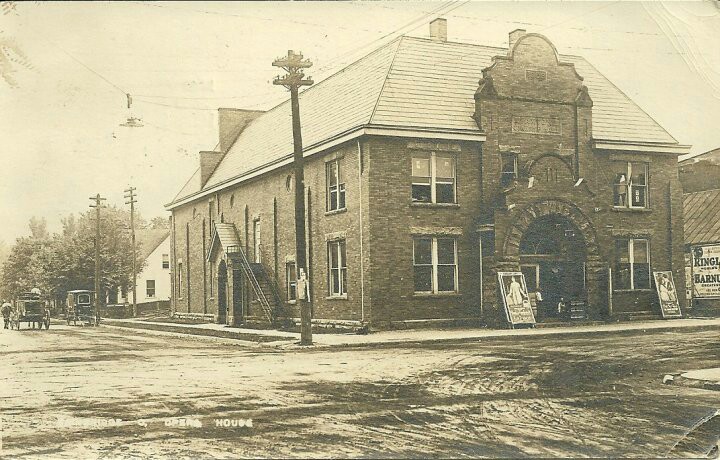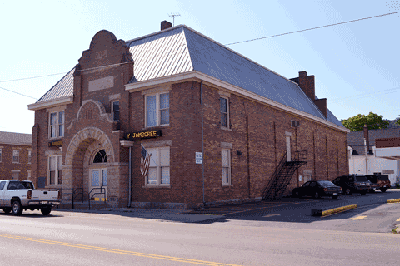Bainbridge – Paxton Theatre
Historic Theaters
CASE Studies


Current Name of Theater: The Paxton Theatre
Current Type: Performing Arts Theatre
Seats: 519
Website: paxtontheatre.com
Historic Names of Theater: The Paxton Theatre
Address: 133 E Main St, Bainbridge, OH 45612
Contact: (740) 634-3333
Email:
Year Built/Style: 1910?
Original Architect: Rittenour and Bowyer of Chillicothe, Ohio
Original Cost: $12,512
Listed on National Register: no
History of Theater:
This brief history of record for The Paxton Theatre was found within a stacked mountain of papers within the walls of The Paxton. Written in 1994 by June Gregg, this document offers a look back at The Paxton and its history.
The Paxton Township Hall on the southwest corner of Main and Maple Streets, may not be the oldest building in town, but when it was recently researched in the township records, it did prove to have an interesting history during its 85 years of existence.
The Paxton Township Trustees obtained the corner lot after three Methodist Churches had burned there, and the church decided to move to another location. The farmers of Paxton Township petitioned the trustees to erect a township hall on the lot, cost not to exceed $15,000. A special election was to be held. Bonds were to run for 20 years, the first $1,000 to come due in five years, and $1,000 each year thereafter. The bonds to sell no less than par, and draw 5 percent interest.
The election was held on the fifth day of November, 1907, and the proposal that the town hall b built was favorably endorsed by the voters. The bonds were offered for sale in March 1909 and sold in the amount of $12,512.
On Aug. 16, 1909 bids on the building were opened (except the electric wiring and heating system) and the contract was awarded to Rittenour and Bowyer of Chillicothe, Ohio in the sum of $12,300 as the “lowest and best bid”.
The hall was built of brick and native stone quarried near Bainbridge, and the initials of one of the stone masons can be clearly seen. After the building was complete, chairs were ordered from the American Seating Co., in Chicago. Two types of chairs were ordered at a cost of $1.85 and $1.50 each.
519 chairs were ordered in birch, cathedral gray, with regular wood arms rests, and one hat rack on each chair. This order was placed through O.R. Kearns who had a store and was also the village undertaker.
Mr. Kearns also ordered the curtains which included: one asbestos curtain to fit opening 18×28 feet, one front or grand drapery border, three sky borders, one landscape drop, one street scene drop, and one fancy interior or parlor scene. There were ordered from Sosman and Landis Co., and the entire list was “to be delivered on stage of the new theater, Paxton Township Hall, placed in perfect working order, ready to ring up the curtain on the opening performance for the sum of $644.”
C.R. Knisley drew the plans for the building and was overseer of the construction. Charles Higgins, stone mason, James Dallas and Griffith Jones are three whose names are prominent as having worked on the building.
On a recent tour of the building (1980) it was found that most of the curtains were still in place, but in bad shape, although the name Sosman and Landis Co. was plainly visible on one of the scenes. The catwalk for the operator of the curtains is still there and the pulley and weights for raising and lowering the curtains. Backstage are dressing rooms, rest rooms, the stairway to the upper floor, and a huge blower.
The first show was Vogel’s Minstrels. Later shows included the player Under Two Flags and Dr. Tulley’s Minstrels. Some residents recall the movies, minstrels, vaudevilles, magic shows and other entertainments held there through the years. In January 1914 Henry Smith and Fred Stutlz rented the building, except the four front rooms, for motion pictures. Griffith Jones installed new wires for the moving picture machine for $51. Ed Baum rented the hall in 1916 to show motion pictures, but the trustees reserved the right to use the hall for Memorial Day, High School Commencements, and Christmas exercises. High School Commencements were held there until the new gymnasium/ auditorium was added to the school in 1936.
The four front rooms were rented to various businesses and the village library was housed there for a while with Elizabeth “Pet” West as the librarian. In the projection room, according to figures on the wall, Robert McCoy ran the picture machine for 1939-1952. Known pianists were Louise Sheible and Jim Newman. The showing of movies was discontinued in the early 1950’s.
Cost of Rehabilitation:
Architect:
Contractors:
Source of Funds:
Renovation Story:
In 1968 James Krug bought the building from the Paxton Township Trustees and rented it out for various entertainments. He sold it to Ralph Cooper in 1992 where he presents The Paint Valley Jamboree, a country western music show, each Saturday night.
In 2014, Tim and Deb Koehl purchased The Paxton Theatre with plans to keep the site alive for many years to come.
![]()

